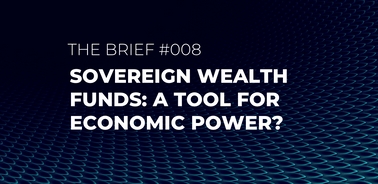- Home
- News And Events
- News
- The Brief #008 Sovereign Wealth Funds: A Tool For Economic Power?
THE BRIEF #008 SOVEREIGN WEALTH FUNDS: A TOOL FOR ECONOMIC POWER?

IN BRIEF
Sovereign wealth funds (SWFs) are shifting their approach from global markets to domestic investments, focusing on key national priorities. Recently, the US, the UK, and other countries are increasingly wondering: could the SWF model be a key tool for economic autonomy in an uncertain world?
THE GIST
Earlier this month, President Trump signed an executive order to propose a US SWF within 90 days, with the strategic aim to “invest in great national endeavors for the benefit of all of the American people.” In October 2024, the UK established a £27.8 billion National Wealth Fund focused on economic growth, foreign investment, industrialization, and the green economy. Funds like these are trending, with governments creating investment vehicles to fund strategic sectors and attract foreign direct investment in the process. They go by different names but can be generally known as Strategic Investment Funds (SIFs), a type of SWF. Unlike traditional SWFs, which broadly focus on preserving wealth, investing conservatively, and stabilizing budgets against economic shocks, SIFs are designed to invest at home strategically in areas like infrastructure, domestic industry, and the green transition. Many are mandated to attract foreign investment, and operate in both the developed and developing world, notably in Africa.
Based on early signs, the US and the UK are two Western countries looking to create strategic sovereign funds, which are unlikely to follow the footprint of traditional funds, like the widely recognized Norwegian Government Pension Fund Global (the world’s biggest sovereign fund, with $1.8 trillion in assets managed). Traditional funds like Norway’s tend to invest conservatively in international public equities (like Apple or Microsoft) and engage very little into the riskier private investment world. It is important to understand SWFs serve different purposes and their designs are unique to country contexts. A paradigm shift in today’s geopolitical context means that many nations are turning inwards to focus on domestic priorities. It is therefore no coincidence that countries are looking to create SIFs, blending financial sustainability with domestic priorities.
However, SIFs also present difficult governance challenges. SWFs have long been a favorite tool of populist and authoritarian leaders, given the funds’ proximity to government coffers with potentially minimal oversight. Without strong governance, they risk becoming tools for political agendas rather than vehicles for future prosperity. Transparency, accountability, and alignment with long-term development goals will be crucial for their success.
THE TAKEAWAY
The Strategic Investment Fund, or SIF, is becoming the sovereign fund of choice. Since 2000, 30 SIFs at the national and sub-national levels have emerged globally. About 40% of total membership, and the 9 newest members of the International Forum of Sovereign Wealth Funds, the largest industry group of SWFs, are considered a SIF. Leading examples of SIFs include Nigeria’s Sovereign Investment Authority, Senegal’s Fonds Souverain d’Investissements Stratégiques and Ireland’s Strategic Investment Fund.
SIFs can be a powerful tool to fuel economic development while simultaneously addressing social and environmental issues. Africa is an ideal location for SIFs to operate, given its development funding gap and growing fundamentals for investment. The continent has a wealth of natural resources, arable land, untapped renewable energy potential, and the youngest population on earth – with a median age of about 20 years old. The infrastructure and development finance gaps are massive (approximately $130-170 billion per year), presenting a dual opportunity to attract global investment while also tackling domestic development needs.
Both developed and developing countries are pursuing the creation of SIFs. Developed nations such as the US and the UK are likely more focused on strategic autonomy, with developing nations probably looking to fund critical social and environmental needs from foreign sources. In any case, for a SIF or any other type of SWF to succeed and enable future prosperity, strong principles of transparency and governance are essential.
DELVE DEEPER
Sovereign Impact Initiative (Center for the Governance of Change at IE University). This flagship initiative of the CGC partners with the UN and the International Forum of Sovereign Wealth Funds to advance sustainable development in Africa and beyond, by mobilizing the expertise and resources of strategic investment funds. The Sovereign Impact Initiative’s components involve applied research, training, and the creation of an investment vehicle.
2024 Sovereign Wealth Funds Report (Center for the Governance of Change at IE University). The 2024 edition of the CGC’s annual Sovereign Wealth Funds report, produced in collaboration with ICEX-Invest in Spain, analyzes the strategies and transformative impact of the investments made by these key global players. It follows advancements in SWFs investing in infrastructure, sustainability, tech and AI, healthcare, and other critical industries.
Strategic Investment Funds: Establishment and Operations (World Bank Group). This World Bank report goes in-depth on SIFs, which have expanded globally, aiming to balance economic policy goals with financial returns. While they can attract private investment and amplify public capital, their success depends on balancing objectives, sourcing viable investments, and ensuring strong fund management. Properly structured, SIFs can be effective tools for national development.